This piece comes to us from Brè Orcasitas. Brè is the author of The Evolving Nomad blog site and a wildland firefighter with 16 years of experience which includes: Engine Crew, Hotshot Crew, Helicopter Rappeller, Smokejumper, and Field Operations Specialist.
Wildfire 101
When you spend your life hiking around steep hillsides, digging in the dirt and sleeping on the ground while surrounded by a sea of other people all doing the same thing it’s easy to forget that the general public doesn’t understand the reality which wildland firefighters live in. As the effects of wildfire on communities increases, so too does the need to understand fire and so, this is my best attempt at providing Wildfire 101.
The History:
Forest fires are a natural event, which have always been a part of any forest’s life cycle. Certain trees actually depend upon fire to help open their cones while other tree species have hardy barks that have evolved to withstand fire.
Native Americans regularly used fire on the landscape for a variety of purposes. Fire was our friend until we decided that it wasn’t. When was that? Immediately following the Great Fire of 1910.
The Great Fire of 1910 caused so much death and destruction nationwide that a unilateral decision was made: “fire is bad.” So new firefighting policies were implemented and from that point forward every fire was to be extinguished as quickly as possible. This is how wildfire was managedfor a very, very, very long time.
The Result:
What if we had the capacity to stop rain from falling? What if a devastating flood took out a major city and we decided to block any precipitation but an occasional drizzle from that point forward? We could anticipate that eventually, the lack of rain would have significant effects on the ecosystem. The same is true of fire.
The result from the fire policy implementations is that many forests are now crowded with young saplings and old growth trees alike. The forest floor is congested with decaying logs and cluttered with brush and shrubs. Over time fire ecologists made enough noise in defense of fire on the landscape that prescribed burning became a regular practice, which began on public lands in the 1950s. However, the budget and support for prescribed burning and forest thinning projects are akin to filling a bucket with one drop of water, we are way off the mark. Notice I said thinning. Thinning and clear cutting are two entirely different things with very different long-term effects.
How does fire work?
Fire can only exist if it has three components: Fuel, Heat and Oxygen. This is known as the fire triangle.
Fuel: In regards to wildfire fuel, anything that is combustible. Pine needles, leaf-litter, shrubs, brush, twigs, branches, dead and live trees, etc.
Heat: Self-explanatory
Oxygen: Reference Tom Hanks finally succeeding at starting a fire in the movie Castaway. “The air got to it!”

How do you stop a forest fire?
There is a great misconception that forest fires are put out using water. While water is a great tool for structure firefighters who work in a city, water is far less accessible to wildland firefighters. In order to use water on a forest fire, you’ve got to be near a road or hike in heavy pumps and hoses to draw water from a nearby water source if one exists. Otherwise, water must be delivered to your location via helicopter with a longline and bucket attachment.
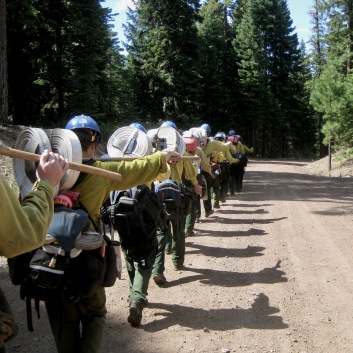

Water and fire retardant are generally used on a forest fire in order to slow the fire’s progression so that ground resources can work to get the fire under control by digging fireline. If firefighters depended solely on water to put out a wildfire, well, we’d have no forests left because they’d have all burned up waiting for more water to be shuttled!
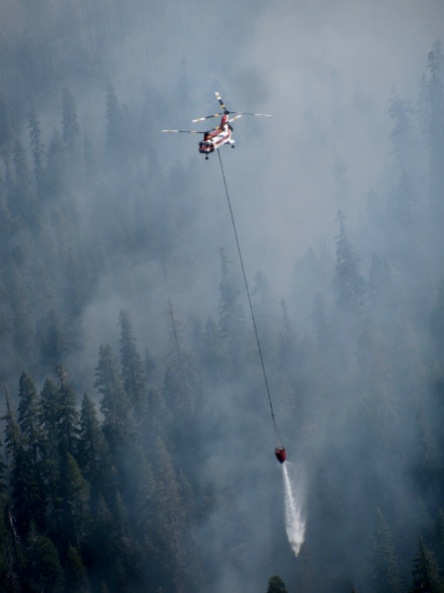
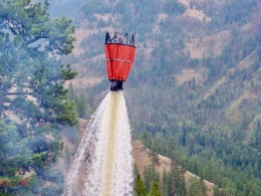
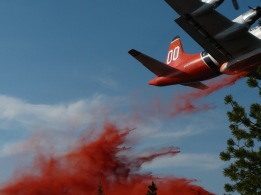
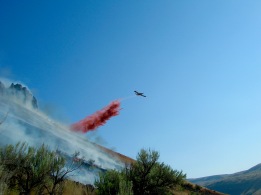
What is a fireline?
If you can conjure up the image of a hiking trail in your mind this will help you to understand what a fireline is. Essentially, firefighters get in front of the advancing fire and dig a wide trail through the forest which the fire will eventually run into. This “trail” is dug down to mineral soil (just dirt) so that when the fire reaches it there is no fuel left to burn. This means that fire loses one component of the fire triangle (fuel) and it dies. A fireline can be 12 inches wide and dug by hand or it could be the width of four bulldozers depending on the severity of the fire’s volatility and the terrain.
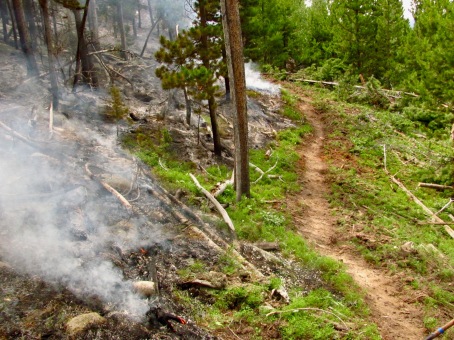
What about that phrase fighting fire with fire?
This is a real thing and it’s one of the best tools in a firefighter’s toolbox. Firefighters dig fireline ahead of the advancing fire at a varying distance depending on fire behavior, weather, and topography. Sometimes firefighters “go direct” meaning you are working close enough to feel the heat from the fire. Other times firefighters “go indirect” meaning that the fire is still a long distance away.
Whenever a fire burns up to the fireline there is always a chance it could “spot” or “slop over.” This means that the fire somehow hopped over to the other side and is now burning past where you had hoped to catch it. One tactic to try and avoid this from happening is to “burn out.”
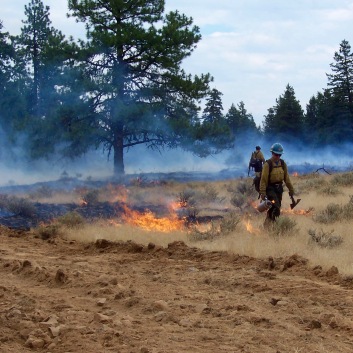
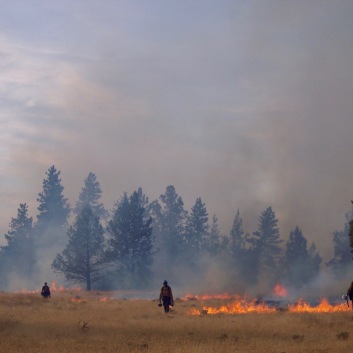
Firefighters use firing devices, often times a drip torch,to start burning fuel that is nearest the fireline in a controlled manner so that the lit fire will burn toward the larger fire and the two will converge far away from the fireline thereby removing the potential of fire crossing over the fireline.
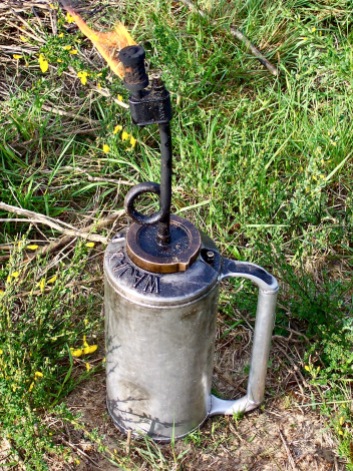
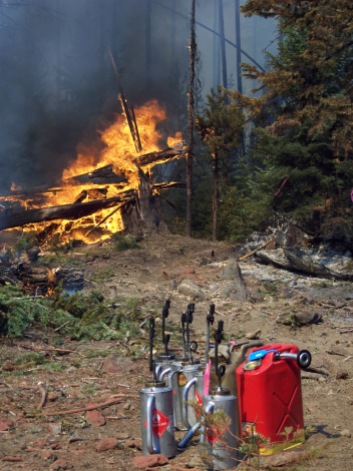
How do wildfires get started?
There are two ways forest fires get started:
Lighting Strikes
When large storm cells move through an area there could be thousands of lightning strikes, although not all of them will actually hit the ground. If a storm doesn’t produce much rain, but it does produce a lot of lightning the storm could create hundreds of wildfires.
Human Caused
There are countless ways that humans cause wildfires. Campers who improperly extinguish their campfires, mechanical equipment or recreation vehicles throwing sparks, trash burning, downed power lines, and arson are all examples of human-caused fires.
Additionally, train sparks can create so many fires that train companies actually have their own fire crews in fire-prone areas. Humans cause exponentially more fires than nature does of her own accord.
How do fires get so big and out of control?
There are several contributors to the intensity of a forest fire.
Since we all now know what a fire needs to exist (see Fire Triangle above) this next part will be a bit easier to understand.
Wind: Wind gives a forest fire more oxygen. Wind can make a fire completely unstoppable. If a fire is “wind driven” a firefighter’s only realistic option is to get people out of harm’s way, including themselves. California is especially affected in this regard due to annual high wind events in specific geographic areas called foehn winds.
Fuel Types: There are classifications for fuel types, but we don’t need to get that technical. Just imagine attempting to start a campfire. You need kindling in order to build enough heat to start the larger branches on fire. Those branches then produce enough heat to start the logs on fire. A wildfire is essentially a very large campfire.
If an area has “light flashy fuels” like tall grasses, brush, and shrubs a fire can move through an area very quickly (Southern California is a good example) whereas, a fire in heavy logs may not move as quick, but will produce a lot of heat.
Topography: Terrain plays a large part in where a fire can go and how quickly. If a fire runs into a “natural barrier” like a wide river or expanses of granite, it will die out unless embers float far enough to reach the other side. Fire moves much faster uphill, especially in light fuels as discussed above.
Diseased Trees: There are health epidemics amongst forests just like in our human societies. One serious issue has been the number of forests affected by the pine beetle. The pine beetle has been killing trees in high numbers leaving them as prime wildfire fuel.
Unhealthy Forests: As mentioned earlier, forest management practices did not allow for natural fire to exist on the landscape for many years. In a healthy forest (of which there are many, for the record), the fire would move along the forest floor scorching living trees but mostly leaving them to survive.
In an unhealthy forest there are a lot of “ladder fuels” which means not only is there a lot to burn on the forest floor (leaf litter, pine needles, downed trees) but there are also shrubs, and smaller diameter trees closely spaced together that generate enough heat to set the large live trees on fire thereby consuming the entire forest, this is called a “stand-replacing fire” and it takes the forest a long time to recover.
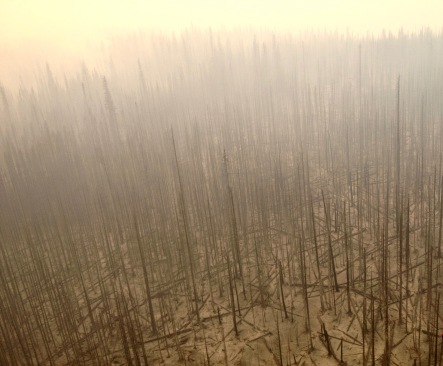
Climate Change: Wildfires depend on low humidity and high temperatures, this combination helps to dry out the fuel and make it more fire receptive, this is why summertime is categorically “fire season” for fire-prone parts of the country. However, you may have noticed (firefighters sure have!) that over the last several years fire season has been getting exponentially longer and fires have been burning more acreage. Climate change has the potential to extend that low-humidity/high-temperature combination further into the spring and fall months making for a much longer fire season until eventually, wildfire occurs all year round.
Why are entire neighborhoods being burned up by wildfires?
Over several decades we have painted ourselves into a corner. A great many people enjoy living near or in the forest in order to be close to nature. That desire is understandable, however, there wasn’t much forethought on the part of some municipalities in regard to ordinances, restrictions or building requirements in these fire-prone areas. This lack of planning has turned into a very serious problem throughout the country.
There are neighborhoods built at the tops of slopes with dry brush filling the entire hillside below them which will eventually catch fire, burn every home down to the ground, then quickly re-grow ready to burn the following year. There are neighborhoods built with only one way in, one way out access. Homes are constructed with fire-prone materials like wood-shake. Many houses have blankets of dry pine needles on their roofs and stacks of firewood sitting on their front porches just waiting to catch an ember.
Essentially, these communities are the fuel. Firefighters put on a different lens when looking at a house, street or neighborhood. Just like a bad accident with many injured people to assess, firefighters perform triage assessments and go to the homes that have a chance of surviving rather than those with trees overhanging the roof, gutters full of pine or leaf litter, or a poorly planned access to the property.
It’s a firefighter’s responsibility to protect life and property, in that order. No firefighter’s life is worth a poorly maintained property (or any property for that matter) and too many have already been lost trying.
A focus on Firefighters
Do Wildland Firefighters work for City Departments?
Although, structure (municipal) firefighters respond to wildfires -mostly to assist with structure protection – wildland firefighters traditionally have no connection to city departments. Most wildland firefighters either work for the government, state or entities like U.S. Forest Service, Bureau of Land Management, National Park Service, U.S. Fish and Wildlife Service, Bureau of Indian Affairs, CAL FIRE or Department of Natural Resources. Which is not to say that there aren’t hybrid firefighting resources with have both structural and wildland fire expertise. These hybrid fire programs continue to be developed nationwide in order to meet the growing need.
Historically CAL FIRE (in California) has had the most experience and involvement within the urban interface areas, meaning that they are much more accustomed than the average wildland firefighter to operating in neighborhoods.
Until very recently wildland firefighting was looked at as a seasonal profession, much like a ski patroller. Therefore, a large number of wildland firefighters are referred to as “seasonals” and do not retain year-round employment. However, as mentioned above, the last several years has proven to show that fighting wildfire is quickly becoming a year-round endeavor.
Is Wildland Firefighting dangerous?
Yes. Although most firefighters would tell you the majority of the time the job doesn’t feel dangerous, wildland firefighters are constantly working in a hazardous environment where even a minor mistake could get someone injured or killed, and that is without even taking the danger of fire into account. Wildland firefighters die in the line of duty at a rate six times higher than that of a structural firefighter. The rate of lives lost in this profession probably makes wildland firefighters more closely aligned with active duty military than city firefighters. For as far back as records have been kept there has never been a fire season where at least one firefighter hasn’t been killed.
Are there different kinds of firefighters?
There are several types of firefighters in order to suit the need of different types of fires.
Engine Crews: An engine crew usually consists of 3-7 people and works from their vehicle, specifically designed for wildfire. Engine crews work along dirt and paved road systems in support of the other fire resources working deeper into the forest. Engine crews are invaluable in the urban interface setting when structures (homes, buildings) are being threatened by an advancing wildfire.
Initial Attack Hand Crew: An “I.A. crew” consists of 10-20 people on average and responds to forest fires in their local area. These hand crews attempt to catch a fire when it is still in its beginning stages.
Helitack Crew: Helitack crews have the same intention as an I.A. hand crew except they fly to the fire in a helicopter and land in the nearby area.
Interagency Hotshot Crew: Hotshot crews consist of 20 people. The crewmembers have several years of firefighting expertise and are therefore given difficult assignments in very unforgiving terrain with minimal support. Hotshot crews respond to fires nationwide.
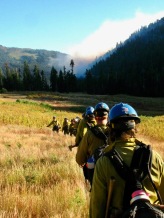
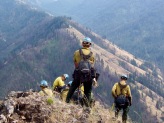
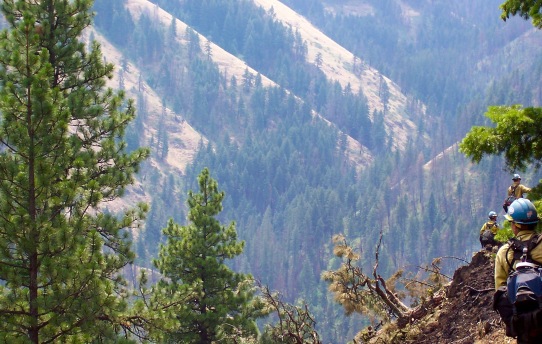
Helicopter Rappeller: A Helicopter Rappeller (you guessed it) rappels off of helicopters from approximately 250 feet above the ground into the fire area. Rappellers respond to lightning-caused fires in very remote areas which could end up taking someone in a vehicle or on foot several hours, or even days to reach.
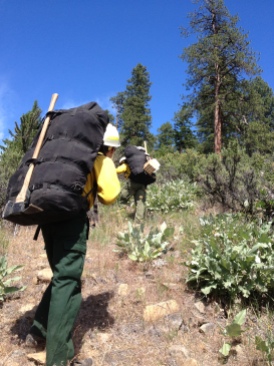
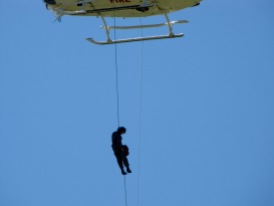
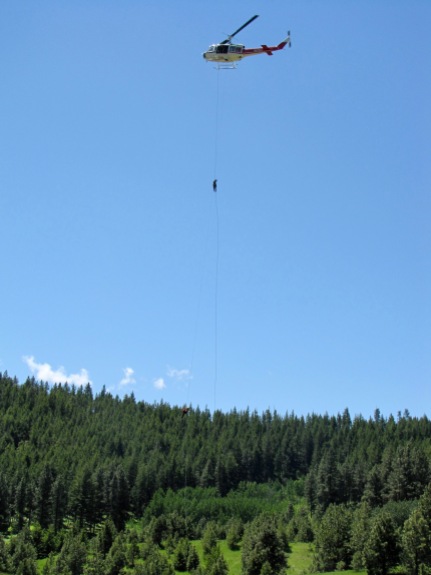
Rappellers usually work in small numbers (2-8) until the fire is out and then pack all of their fire gear (the average pack weight being 100lbs per person) out to the nearest road to be picked up, which could be several miles away. Rappellers get strategically placed throughout the fire season in order to respond to fires nationwide.
Smokejumper: Smokejumpers have many similarities to Rappellers except Smokejumpers parachute from a plane into the fire area rather than rappel off a helicopter. They have the potential to work in slightly larger numbers of up to 20 people (planes are larger than helicopters and hold more people). Smokejumpers require additional skill sets (e.g. technical tree climbing, etc.) and specialize in managing the complexities of rapidly growing fires.


Smokejumpers land near a wildfire. Smokejumpers are unique because of the way they reach the fireline: they parachute from an airplane 3,000 feet above the ground. When wildfires ignite in remote and isolated locations, smokejumpers are able to reach them fast – because they can parachute to wildfires when there are no roads or trails nearby – and get to work long before anyone could hike or drive to the fire.
Smokejumping is a physically and mentally demanding line of work that requires a broad knowledge of firefighting. Smokejumpers are also heavily involved in prescribed fire management and hazardous fuels reduction efforts.
What is a typical day for a wildland firefighter?
The standard shift for a wildland firefighter is 16 hours on with 8 hours off. A typical fire assignment (when traveling away from the local area to respond) lasts 14 days. Upon completion, a firefighter will receive two days off then go back to fighting fire. This schedule is repeated (14 on, 2 days off) from the beginning of the fire season through to the end. There are variations to this schedule depending on what type of fire resource someone is, but this is absolutely a hotshot crew’s life. Most hotshot crew firefighters work 1,000+ hours of overtime every fire season. Essentially, if you’re awake, you’re at work… for six months straight. With the fire season extending longer each year, so too does the strain on firefighters.
Here is what a typical day on a hotshot crew looks like:
5am – Wake-up!
5:01-5:10am – Mad Frenzy to ensure that you aren’t the last ready
5:15am – Walk through the darkness in a single file line to get breakfast from a semi-truck kitchen in fire camp
5:45am – Accomplish all tasks necessary and attend a morning briefing before heading out to the fire
6:45am – Drive to an access point for the fire and park vehicles
7:45am – Crew briefing
8:00am – Hike to a specific area of the fire (the fire is generally thousands of acres so it is broken into “divisions”)
9:00am – Begin working for the day
(common work assignments)
- Scout the fire area to decide the appropriate placement of a fireline
- Assess potential hazards to firefighters
- Use chainsaws and hand tools to create a fireline
- Prepare for burn out operations
- Perform burn out operations
- Assess any structures located within the fire area and prepare them for fire to pass through
- Mop-up
7:00pm – Refurbish fire gear for the next day
8:30pm – Arrive at fire camp and eat dinner from the semi-truck kitchen
9:15pm – Make a phone call (If you have cell service)
9:30pm – Brush teeth
9:45pm – Roll out a sleeping bag on the ground and settle in
10:00pm – Drift off to sleep looking at the stars overhead while wondering if the work you put in that day will hold the fire
(Notice showering was not listed in the timeline? Sleep is precious and showering is a rarity)
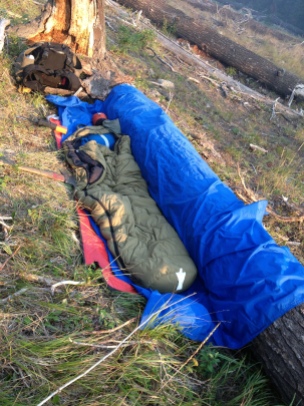
That’s an easy day when everything goes according to plan. There are also days that start off fine enough, then the next thing you know it’s been 30 hours without sleep and you’re so tired that you’ve got what feels like the mental capacity of a drunken five-year-old.
Firefighters do this job and love it even though the pay is quite low for the level of fitness it requires, the level of danger associated with the profession, the duration of time away from family, and the toll it takes on the body. The entry-level federal wildland firefighter starts at a GS-3 wage, while the average career firefighter is between a GS 5-9 wage.
Looking at the standard wage makes it pretty clear that this is more than just a job, it’s a way of life. Working outdoors in a hard labor job and bouncing around from one fire to the next ,rarely getting the opportunity to use indoor plumbing — these are just parts of the job. So is hiking in steep terrain and spending most of your day drenched in sweat… it’s a love-it or hate-it career no question. However, the people on either side of you who are also drenched in sweat make the time fly by with laughter and camaraderie. You can’t put a monetary value on that.
What can I do to protect my home and neighborhood from wildfire?
I’m so glad you asked.
Our best hope of protecting communities from wildfire is to be armed with knowledge, which is the intent of this entire article.
Understanding that while it is a structure (city) firefighters’ job to respond to house fires, wildland firefighters have different responsibilities. We save houses if it’s possible to do so safely, but our job is to put out the forest fire, which again shows the need for the up and coming hybrid firefighting resources.
Learning how to protect your home and neighborhood using methods like defensible space along with other firewise recommendations is key. In addition to learning about firewise methods, another valuable component is to support your local fire resources in their efforts to maintain healthy forests. Supporting prescribed burns in your area and accepting a bit of smoke hanging in the air really does go a long way. This is definitely a situation where “less is more”. Most anyone would prefer 24 hours of light smoke rather than 24 days of thick debilitating smoke.
Some parts of the country are at much higher risk for fire than others just as some parts of the country are more prone to tornados. If you live in an area with moderate to high fire risk it’s important to be ready. The recent California wildfires have shown how every minute counts to get out and get to safety, especially in densely populated areas.
As I mentioned earlier the wildland firefighting community experiences loss of life every year, people whose job it is to fight fire die in fires, which means standing in your yard with a garden hose intending to “ride it out” is a terrible idea and it’s one that will probably get you killed. Timely evacuations are the safest option for the public and they make a firefighters’ job easier as well.
How can I support firefighters?
Seeing homemade thank you posters along the sides of the road near fire camps truly does mean a lot to firefighters. Hand drawn cards from kids delivered to fire camps for firefighters to see? Fantastic. Throughout my fire career, people have been incredibly gracious when recognizing my nomex pants and fire boots while traveling from point A to point B, and have thanked me for my service or offered to pay for my coffee. A stranger once paid for my entire fire crew’s dinner bill at a restaurant without our knowledge.
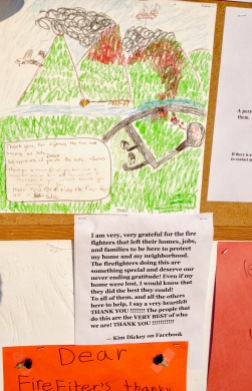
The thing is, wildland firefighters are terrible at accepting thanks or acts of kindness. We chose a profession in public service and are the ones who give; receiving often feels very uncomfortable. Government employees (which most wildland firefighters are) actually cannot accept any gift over $20 dollars anyhow, so it’s probably good that we’re squirrely when it comes to these matters.
In my personal opinion here’s what supporting a firefighter looks like:
Supporting a firefighter means doing your part (or hiring a firewise company) to protect your home and community so that our lives aren’t endangered trying to save houses and other structures.
Supporting a firefighter means supporting the efforts in progress to maintain healthy forests through prescribed burning, thinning, and the development of firebreaks where necessary. This also includes letting wildfires burn when they pose no threat to structures because we need fire on the landscape and often times it’s the safest option for firefighters.
Supporting a firefighter means never again using the phrase “battling the blaze” (all media outlets, I’m talking to you) because it’s a ridiculous phrase and no firefighter has ever called a wildfire a blaze. How did this silly term get started anyhow?
Supporting a firefighter means giving us delicious homemade brownies. (Of course, that last one is a joke but I for one would never turn down a homemade brownie.)
Was this article long? Yes.
Believe it or not, we barely scratched the surface. I’m hopeful that the information provided here will leave you with a better understanding of how wildfire works and what we can all do to better co-exist with wildfire on the landscape.
This article originally appeared on The Evolving Nomad website.

